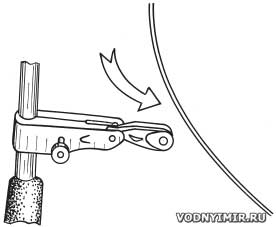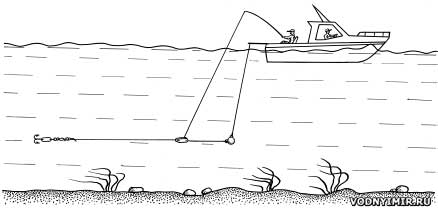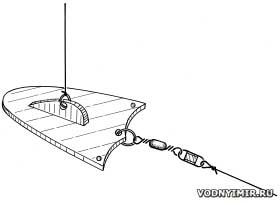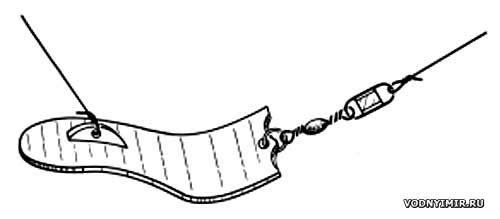Trolling. Trolling pike fishing
 In Russia, pike have long been caught on the track. In the simplest version, this required a fishing line on a reel, to which a spinner was tied through a metal leash. It usually requires loading in the form of a spinning sinker. That's all. Nothing superfluous, except that by the end of the last century, a spinning rod began to be used more often instead of a reel. But recently, a lot of various technical devices have appeared for wiring a spinner using a moving boat, and the method of such fishing has been called the tricky word «trolling».
In Russia, pike have long been caught on the track. In the simplest version, this required a fishing line on a reel, to which a spinner was tied through a metal leash. It usually requires loading in the form of a spinning sinker. That's all. Nothing superfluous, except that by the end of the last century, a spinning rod began to be used more often instead of a reel. But recently, a lot of various technical devices have appeared for wiring a spinner using a moving boat, and the method of such fishing has been called the tricky word «trolling».
Characteristics of reservoirs. Trolling pike is usually caught in large lakes and reservoirs. It is where there are large areas for feeding white fish and where it gathers in large flocks, there is a chance to catch a trophy pike specimen. In Scandinavian countries, toothy fish are caught in fjords, channels and bays. There are a lot of trophy pike in the heavily desalinated areas of the Baltic Sea, so Finns and Swedes often boast of enviable catches. The flotilla of trolling fishing enthusiasts in these countries is considerable. Comfortable boats bristling with trolling gear can be seen not only in every port, but almost near any coastal settlement.
The Rybinsk and Gorky reservoirs are the most attractive for catching trophy pike here, Ladoga and Onega lakes, as well as many lakes in the North of Russia, of which the most accessible reservoirs of Karelia.
For trolling, you need to choose reservoirs with a depth of 2 to 7 m, not particularly twisted. Trolling is more difficult to catch deeper, at least on wobblers, which are considered by pike to be one of the most catchy types of baits. Usually, fishing is chosen in waters remote from the shore with a flat or changing bottom relief. Wiring along the algae is ineffective, since hooks constantly follow, besides, in shallow water, medium-sized pikes most often bite.
Equipment. Outboard motors. Trolling is usually used to catch several rods at the same time from a boat or a boat equipped with a motor that provides the quietest running during wiring. With pike trolling, both gasoline engines and electric ones powered by a battery are used. For example, very reliable electric motors are offered by the American company «NINN KOTA». One of its models — «Endura» — is distinguished by the fact that during prolonged operation it heats up significantly less than many models from other manufacturers. As for gasoline engines, «HONDA», «MERCURY» and «YAMAHA» offer high-quality units with a capacity from 2 to 250 horsepower.
Of course, the boat or boat is selected according to the power of the motor. Super-strong motors are installed on special high-speed vessels. A motor with a capacity of up to 100 horsepower is installed on medium-class boats. For example, on a well-known «Kazanka» it is quite possible to install a motor with a capacity of up to 30 horsepower. There are high-speed inflatable boats with a rigid bottom and a reinforced structure, for which a 50-80 horsepower motor is suitable. For trolling fishing, it makes no sense to use more powerful motors.
Many models of rubber inflatable boats designed for slow-speed navigation, as well as other light watercraft, are well suited for the use of electric motors. There are a lot of manufacturers of light boats, and the model range is large.
Echo sounder. This device is indispensable when trolling, as it allows you to detect edges and pits at the bottom and hold the bait at an angle to the piles or parallel to them. The echo sounder shows the structure of the bottom, which is important, since the pike does not like too silted bottom. Also, the echo sounder shows the position of the fish in the water layers or at the bottom, its size. The echo sounder captures the location on the bottom of large objects (such as boulders, driftwood, firewood), behind which a pike can hide.
Portable navigator. This is a device that determines your coordinates on a scalable map. It remembers the necessary points or route, and then you can easily go through them again or return to the desired point.
Rod holders. The stern and sides of the boat (boat) must be equipped with special holders for the installation of rods. They can take the form of nests or special grips.
Tackle. The term «trolling» is a derivative of the word trail («drag»). For trolling, special rods are produced with a length of 1.8 to 2.7 m. For example, the company «A-elita» produces good rods «Catfish» and «Trolling». The fishing line is used, as a rule, braided with a diameter from 0.18 mm to 0.25 mm. The use of overstated test scaffolding is due to the fact that when wiring and an unexpected hook, it is not always possible to immediately stop the boat, which is why a thin fishing line can easily break (especially if the coil brake is heavily tightened). Leashes and tees will be discussed below.
 Fig. 1. Triggered outrigger. |
Outriggers, downriggers and paravans. Outriggers are used to control biting and self-seeding of fish in case the angler did not have time to react to the bite, as well as to reduce the load on spinning. This is a rod mounted on a whip, closer to the handle, a special adjustable clip into which the fishing line is inserted. The device is quite simple (Fig. 1). The clamping screw allows you to adjust the output force of the fishing line when biting. Outriggers are used in combination with sinking sinkers, paravans or without them — with one bait.
Downriggers are special devices for sinking the bait, wiring it at a certain depth and controlling the bite (Fig. 2). Our anglers have started using them during lake fishing quite recently, but have already appreciated it. The fact is that traditionally, trolling fishing, as well as spinning, uses baits designed for a particular depth of immersion. However, the game of, say, deep-sea wobblers is significantly different from the game of surface baits. At the same time, the predator often reacts to the game characteristic of baits designed for a small depth, while he himself keeps at the bottom. In this case, the downrigger comes to the rescue. This device allows for trolling fishing quickly lower any bait to a given depth and accurately conduct it in the lower layer of water. To do this, you can even use ultralight rods, which significantly affects the quality of vyvazhivaniya medium-sized, but lively fish. The fact is that here, when wiring, the entire load falls not on the rod, but on the clamping clip, so you can even use baits with high drag, in combination with not so powerful rods.
 Fig. 2. Trolling with a downrigger. |
The downrigger consists of a winch, boom, cable, cargo and a special device with a clip that regulates the clip of the fishing line. When biting, the fishing line comes out of the clip. With one downrigger, you can simultaneously use two spinning rods, setting their rigging to different depths and ranges. If you put two downriggers on the sides of the stern, then four spinning rods can be installed at the same time, and if the stern is wide, then another downrigger can be placed between the first and second. Depending on the depth of the bait and the speed of wiring, the weight of the load can be reduced or increased (on some devices — in the range from 0.5 to 8 kg).
Today, foreign manufacturers produce downriggers of various modifications — from the simplest, with manual mechanical drive to automatic, connected to a computer.
With a downrigger, you can fish for baits of the widest range — various wobblers, rotating and oscillating spinners, artificial minnows, silicone worms, octopuses, jig baits, all kinds of tackle, etc. The decisive factors when choosing a bait are the transparency of the water and its illumination.
 Fig. 3. Paravan. |
The simplest paravan can be cast from lead, and branded ones are made of plastic containing a lead weight (weighing 25-140 g). There are wave-shaped paravans to give the bait a diving effect (Fig. 4).
 Fig. 4. Wave-shaped paravan. |
In some cases, it is advisable to put an elastic shock absorber between the paravan and the leash.
Pike trolling and bait tactics
In large lakes and reservoirs, large, mature pike during the period of active feeding often pursues clusters of forage fish. These can be flocks of bream, bluefish, gaster, roach, perch. Sometimes flocks consist of mixed species, for example, bluefin, gaster, roach and bream. These fish go close to each other and, finding feeding areas, feed together. Pike can surround a feeding shoal and eat fish along its edges. But sometimes a large deep pike chooses a wait-and-see tactic when hunting and stands at the bottom, at a point that it likes. And if an object suitable for her nutrition is in her attention zone, an attack immediately follows. Of course, if the pike has an appetite, which it has a cyclical character.
The correct selection of trolling bait ensures success in fishing. The place of the caught pike is very quickly taken by another predator. This is confirmed by the experience of many anglers. It is unclear what this is connected with.
By the way, on large lakes and reservoirs, summer pike fishing is much more effective than autumn. This is another mystery. After all, according to the prevailing opinion, pike should peck best in the fall, when it needs to stock up on fat for a long winter. In summer, large pike are caught on medium and large wobblers, large «oscillators», medium and giant vibro-tails, on large twisters. Soft baits are mounted on special heavily weighted jig heads. By the way, when fishing in many remote and not too much exposed to fishing pressure reservoirs, success is ensured by «Storling». This large oscillating spinner has been known to anglers for more than a dozen years, but it «works» just as well as before.
In autumn, pike is caught on the same baits as in summer. But still there are differences in autumn fishing. For example, in summer, a fairly small «Bool head» wobbler with a red head and a white body can be a catch bait, designed to catch both large deep bass and pike. Bites on him were rare in the fall, but still they happened more often than on other wobblers. Of course, out of competition in the fall, «Rapala» is a roach-shaped wobbler, 17 cm long, with a broken blade. Pike bites infrequently, but steadily, on this bait in summer and autumn. But the wobbler «Long-A» of the company «Bomber» under good conditions, the predator often takes. However, in the fall, «Long-A» did not show itself, whereas «Rapala», with methodical catching of points fixed on GPS, sooner or later provoked a bite.
The wobbler «Bomber» «Long-A» in summer during pike activity can be a very catchy bait. He very accurately imitates a live fish that has strayed from the flock. With proper wiring, it trembles slightly, and the vibrations coming from it provoke the pike hunting instinct, make it rush to the bait. But if the wobbler catches at least a little algae, then its game immediately changes, and the pike does not react to it. In this case, you need to choose a fishing line and release the hook from algae.
By the way, they say that the pike does not distinguish the color of the bait, and therefore only the shape of the bait and its tactical and technical characteristics are important. But this is not the case. Experience shows that during pike feeding, bites follow one after another on green and gray «Long-A» wobblers, and the predator ignores blue baits.
In summer and at the very beginning of autumn, when fishing in large reservoirs, a good catch is provided by very large wobblers — up to 40 cm long. Trophy pike is often tempted only by extra-large baits, as it does not like to make unnecessary movements. She needs to get a lot of little things to get enough, but swallowing a large feed object immediately and for a long time satisfies her appetite.
Leashes, swivels, carbines. When trolling pike fishing, these small details play a very important role. It happens that a fisherman irons water expanses on a boat for days, and when he finally cuts a captured pike, it suddenly comes off because the leash turned out to be too short, or the carbine straightened, or the swivel broke.
For trolling pike rigging, metal braided, but soft as a cord, leashes with a length of at least 50 cm are well suited. They must withstand a load of up to 50 kg. Only such leashes are considered reliable when catching a large treacherous pike, whose weight, however, will not be so great. But a margin of safety is always necessary.
Swivels and carbines. To catch large pike, you should not use swivels and carabiners made of brass steel. They may not be able to withstand strong jerks. It is necessary to use connecting elements made only of high-quality steel with a special coating. For example, the company «OWNER» uses a special resistant coating «Black Chrom». The swivel on the ball bearing ensures soft and flawless operation of the bait and prevents twisting of the fishing line during fishing.
Tees. Usually the wobblers of leading modern firms are equipped with reliable sharp tees. However, if there is a need, you can replace the tees that do not suit you with very high-quality tees of the «OWNER» company of the ST-36RD series, which have a red coating for additional attention of the fish. The same company produces models of tees that sit securely in the mouth of the fish, but at the same time, under the influence of the applied force, they bend well on snags. However, such hooks may not withstand too large a pike.
Vyvazhivanie. Pike is a treacherous fish, and this heats up the trolling's fishing excitement. Toothy — one of the most active freshwater predators — is worth hunting for. This is especially true of mature predators that live in the depths of large reservoirs.
Here is how our friend, angler Vladimir Agafonov, describes his impressions during the capture of an almost pood pike: «When she took a bite, the rod flew out of the holder, and I managed to pick it up because it caught the coil on the wire of the echo sounder. At first there was a feeling that the spinner was hooked on something. Then suddenly the fishing line sagged. I began to reel it in very quickly, without feeling any heaviness. The fact that something was still sitting on the tee could only be guessed by the slight vibration of the spinning tip. But who would have thought that a huge pike behaves so insidiously! She was walking very fast towards the boat.
Then she started jumping out of the water. Ordinary-sized pike in such cases make a candle on the tail, shake their head from side to side. The same beast emerged from the water, bent in the air like a dolphin, and went headfirst into the water at an acute angle so as not to lose attack speed. I had to work hard to tire her out, bring her to the boat and take her into the podsak.»
About the taste qualities of mature pike. There is an opinion that a large pike is not good for food. Perhaps, but this applies to pike that lead a sedentary lifestyle in ponds, small rivers and other small bodies of water. The same pike that feeds on the vast expanses of huge lakes (especially our northern and western ones, with a solid bottom and clean water) and reservoirs, is forced not to stagnate in one place, but to move behind shoals, because it needs to eat a lot to compensate for the energy spent. Moving a lot and eating a lot, such a pike quickly gains weight and becomes very tasty. It may taste like sturgeon. In general, a mature pike actively moving through huge water spaces is an elite trophy!
Share this page in the social. networks or bookmark:
